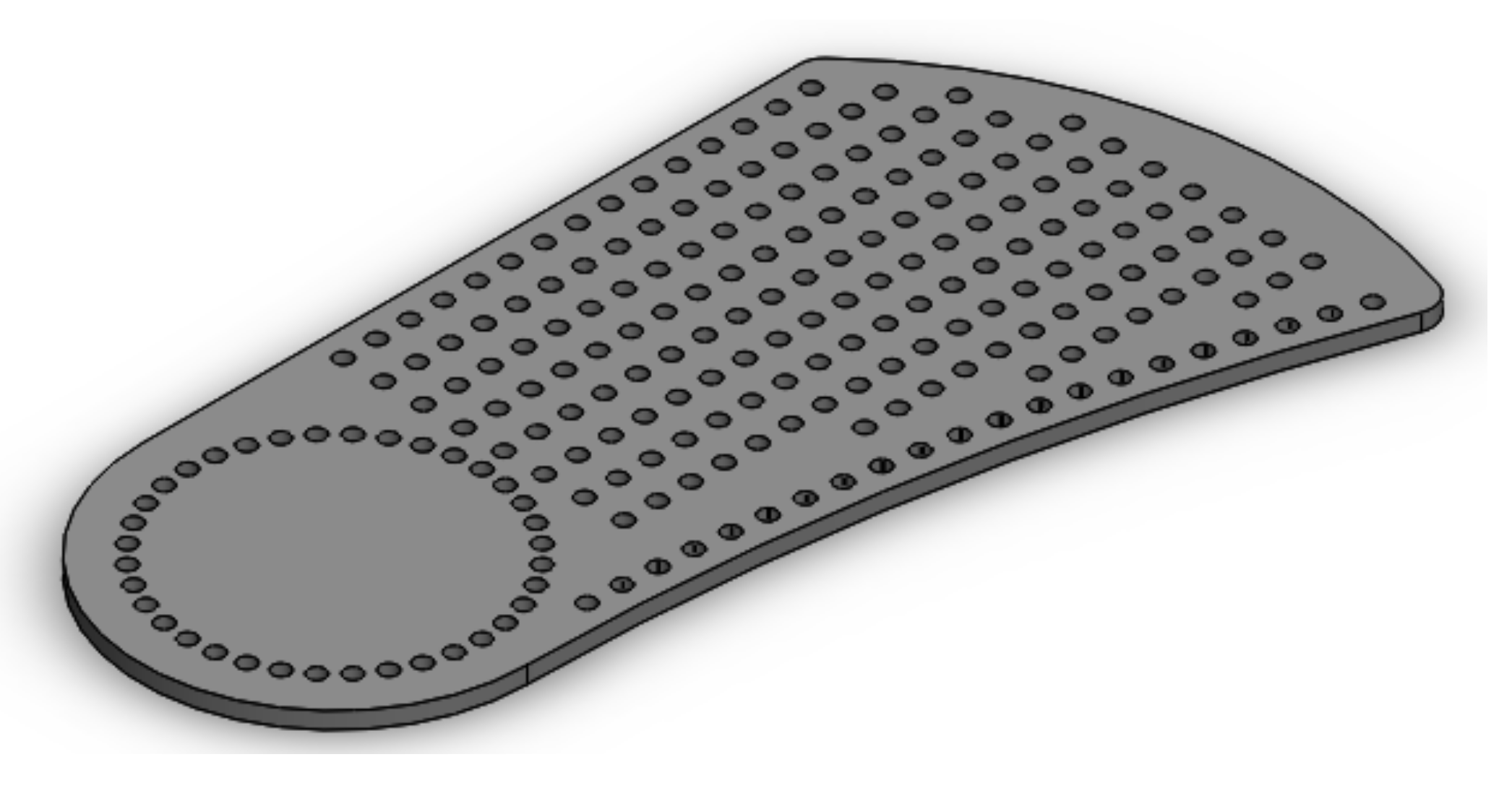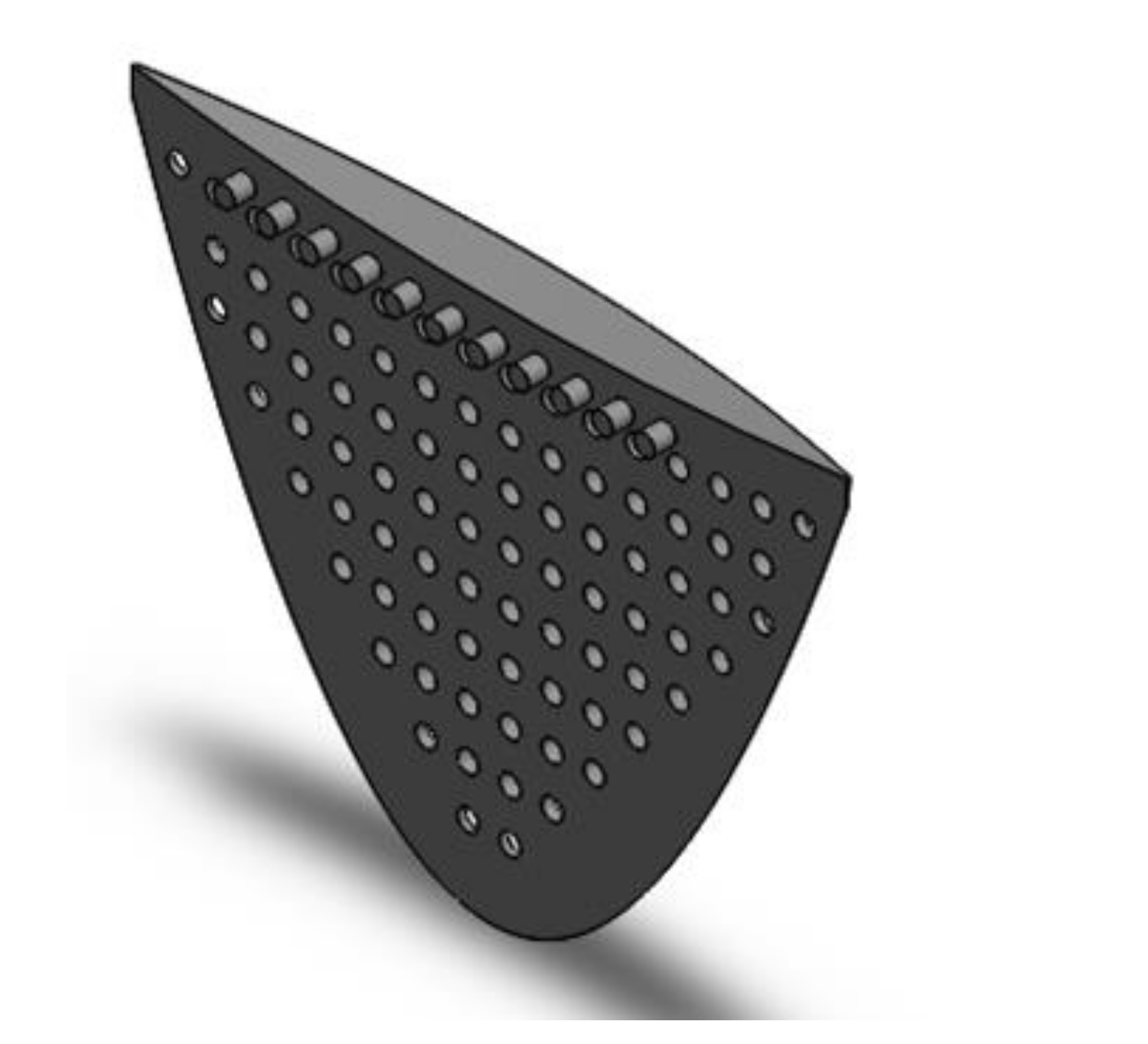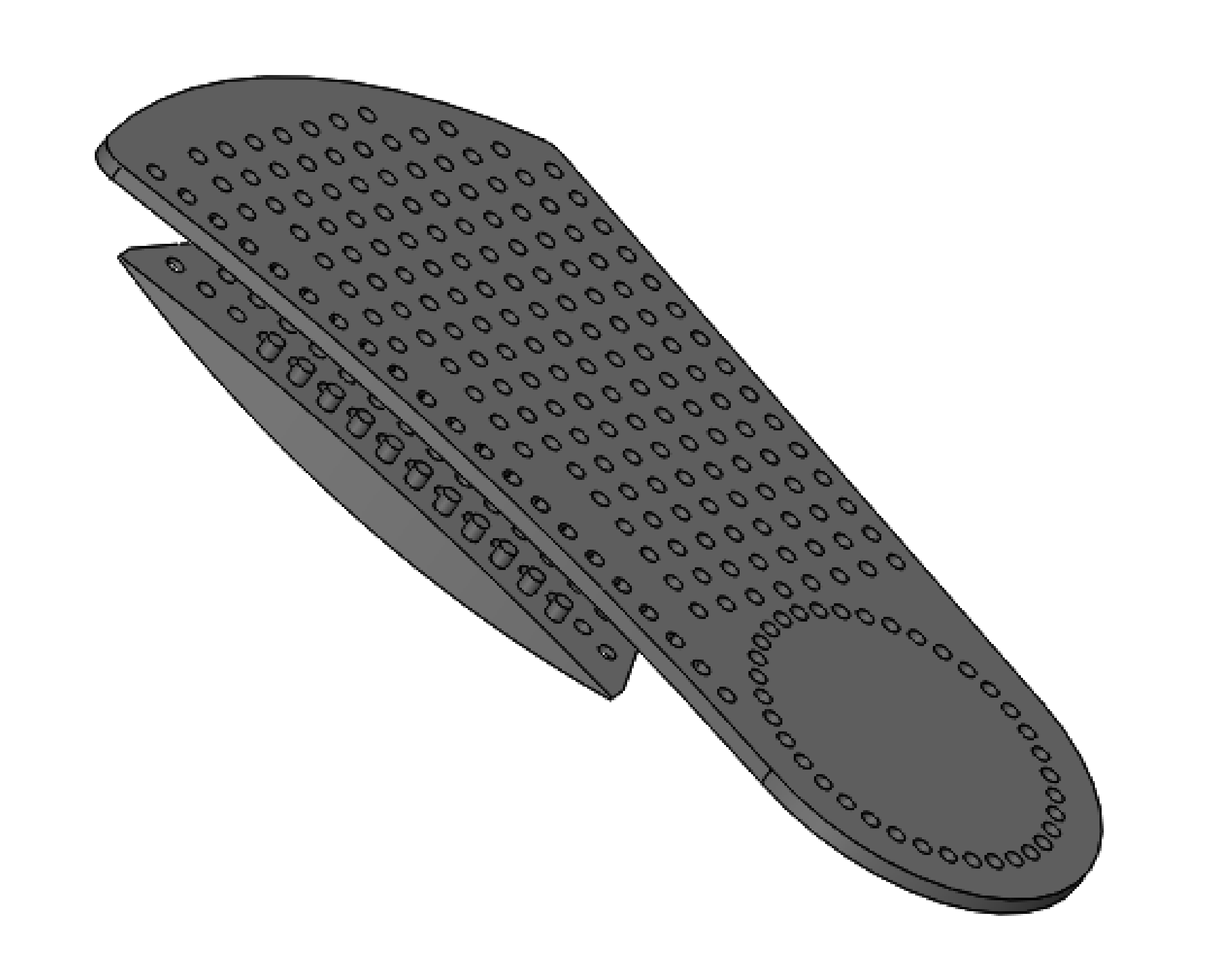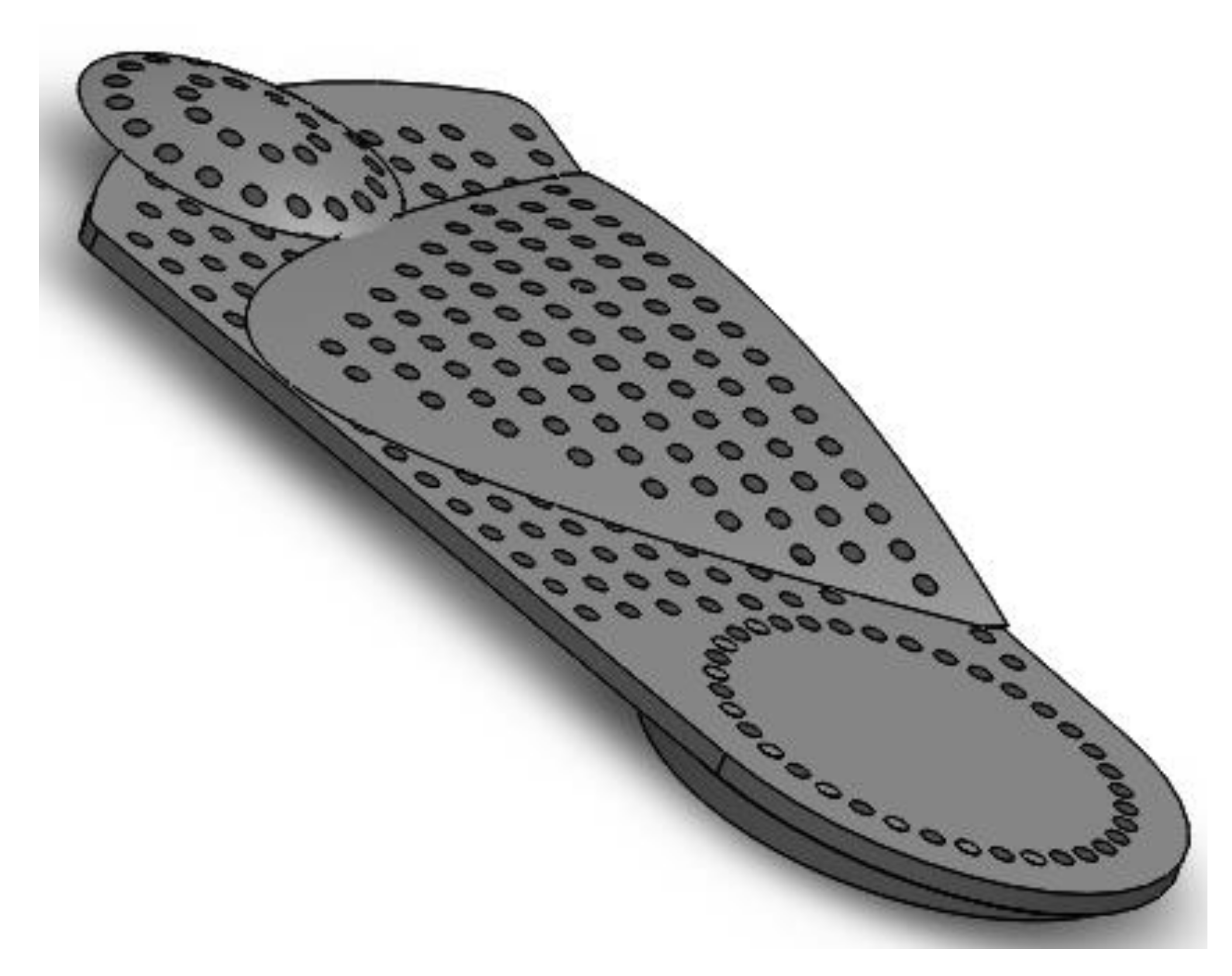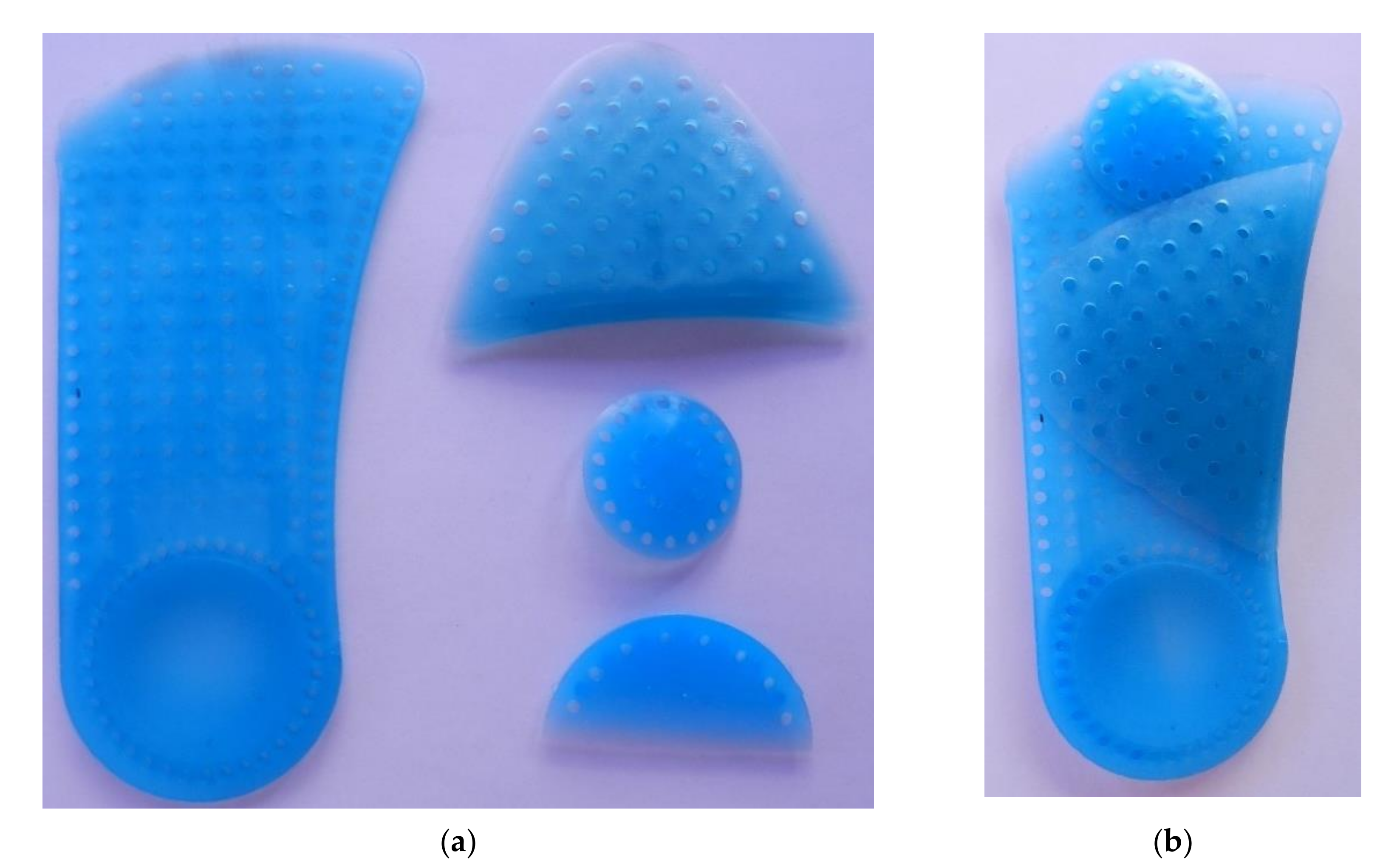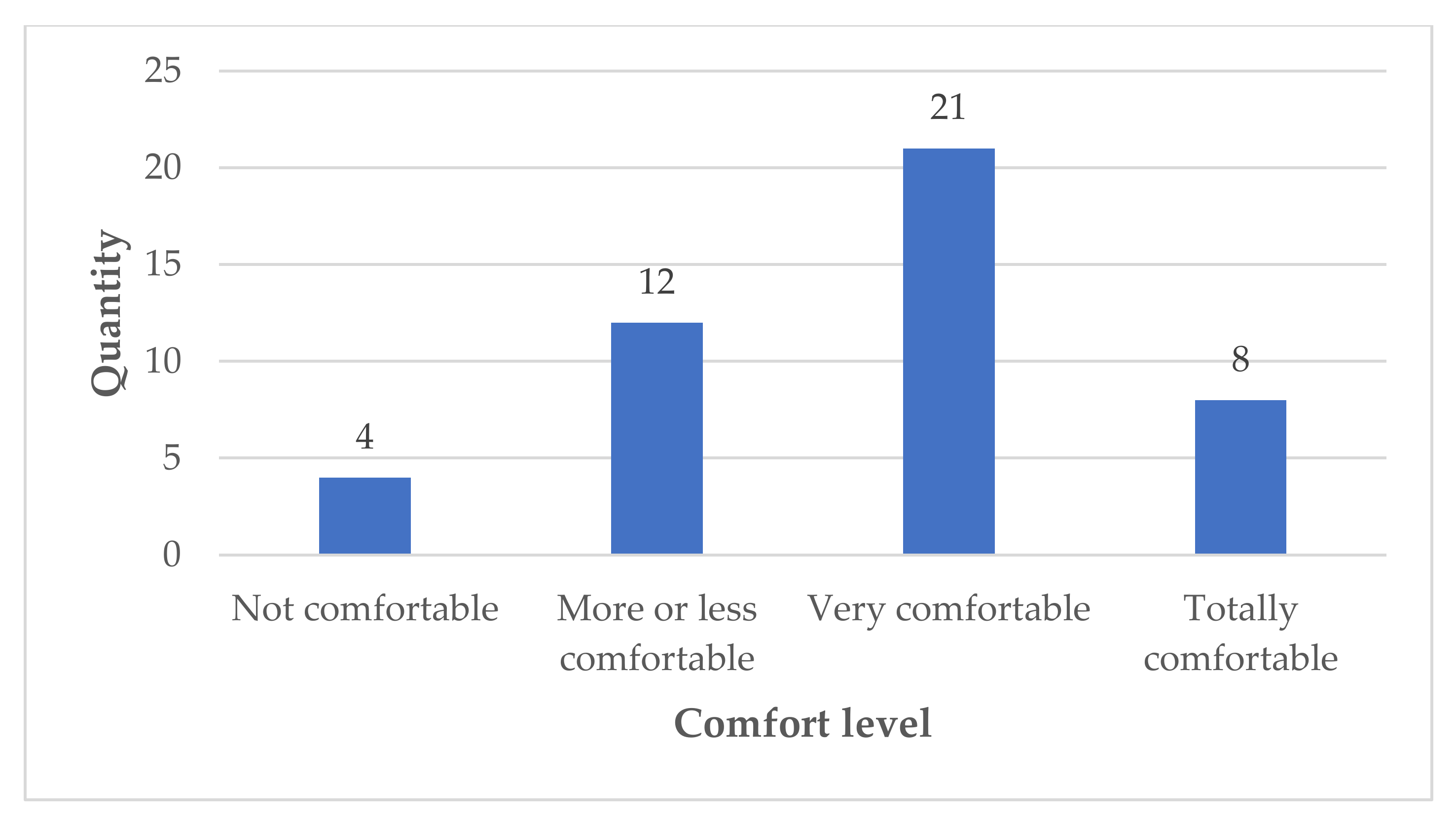1. Introduction
The scientific-technological development allows us to increase productivity and efficiency in industries with dynamic and competitive markets [
1], such as the medical industry. The application of engineering knowledge to various fields of medicine has contributed to the improvement of medical products, equipment, and services that safeguard the quality of people’s lives [
2]. The medical devices sector has benefited from the incorporation of engineering principles in its product development and production process optimization to achieve competitiveness in the market through innovative and quality solutions [
3]. Innovations in this field refer to the creation of new devices or the improvement of existing ones, through the development of a series of stages that start with the generation of an idea, continuing with the establishment of specifications, and ending with the commercialization of the device [
4]. The demand for medical devices has increased in recent years, with demographic aging being one of the factors contributing to this increase. Orthopedic devices, in particular plantar orthoses, have followed this trend by being considered functional aids to improve people’ mobility conditions. In 2015, the global market for plantar orthoses alone reached revenues of 2.6 billion dollars, and it is estimated that by 2021 these will increase by 45% [
5].
Plantar orthoses are used in medical practice to treat various conditions of the feet and lower extremities. The safety and efficacy of orthoses are duly supported by various technical and scientific studies. For this reason, there are clinical protocols that prescribe them to achieve correct posture of the feet and reduce pain during standing and walking [
6]. Any device that is placed inside a shoe and is in contact with the sole of the foot, can be considered a plantar orthosis. According to their manufacturing process, they can be classified as “custom-made” or “prefabricated” [
7]. The challenge, in both cases, is to make the design of the plantar orthosis consistent with the anatomical features of the foot and the treatment needs based on the condition. Customized insoles achieve a greater approach to that requirement [
8].
The complexity of designing a prefabricated plantar orthosis lies in the fact of considering all the possible morphological and pathological variations of a patient’s foot. For instance, the height of the medial longitudinal arch of the foot is a very important aspect to consider because the shorter it is, the greater the possibility that the patient will present a foot in pronation, whereas the longer it is, the greater the possibility that a foot in supination is latent [
7]. In view of the above, there is an area of opportunity for a prefabricated plantar orthosis design to solve the design challenge that lies in determining the position and height of medial longitudinal arch and heel supports in accordance with the plantar arch and lateral heel deflections [
9], as well as the incorporation of transverse arch support to reduce plantar pressure under the metatarsal heads [
10] in cases of metatarsalgia that are or are not associated with the height of the longitudinal arch of the foot.
There is a wide variety of prefabricated plantar orthoses on the market, the majority of the designs of which have the characteristic of being one-piece systems, cushioned in a specific area and with predetermined fixed supports. The disadvantage of the prefabricated systems is presented in the area of the orthosis where the support has been predetermined, due to the fact that, in many cases, it does not coincide with the plantar region that the patient requires to be attended to. Therefore, clinical professionals believe that a custom-made orthosis has a greater chance of performing the desired function, provided that it is manufactured based on individualized requirements according to the morphology of the foot and the condition to be treated [
11]. In addition, custom-made systems can satisfy the great variability of design specifications required by health professionals in the absence of guidelines regarding the prescription of plantar orthoses [
5]. However, custom-made orthoses also have disadvantages. Firstly, its manual manufacturing process long and laborious, and the skill and experience of the orthotist is the influential factor in ensuring that the orthosis has the prescribed technical characteristics [
12]. Secondly, there is the competitive disadvantage in relation to its cost compared to prefabricated orthoses, whose standardized manufacturing processes allow time and cost optimization [
13]. In view of the dilemma of choice between the two types of orthosis for the treatment of certain pathologies, studies have been conducted that conclude that no significant difference is found between custom-made and prefabricated orthoses [
14]. The aforementioned issues validate the functionality of prefabricated orthoses for the treatment of certain conditions, implying access to an alternative solution at a lower cost.
This paper introduces a plantar orthosis design to be manufactured in a standardized way and with the ability to be customized based on the pathology that the patient exhibits. These characteristics unify the benefits, advantages, and qualities of prefabricated and custom-made systems. The system is intended to reduce the time and cost of manufacturing custom plantar orthoses. The main feature of the design is its modularity. It is divided into four independent components (modules) that are related to each other: plantar base, arch support, metatarsal button, and rearfoot wedge. The plantar base is the central module, while the other three are movable and attachable to it. The coupling is made by means of a bolt-hole assembly mechanism that allows the mobile modules to be positioned in the area required by the patient according to his or her condition. Thus, the proposed system can be configured to avoid pronation or supination movements of the foot, using the arch support and rearfoot wedge, and overloading the metatarsal region, by using the metatarsal button. On the other hand, the design can satisfy the variability of technical specifications that clinical professionals prescribe, due to the autonomy it would give them to configure the system based on their criteria and adapt it to their clinical treatment protocol.
The characteristics of the proposed plantar orthosis design were obtained through the application of Theory of Inventive Problem Solving (TRIZ) methodology. This methodology has a set of techniques and/or tools that guide the product development processes from the generation of creative ideas to find innovative solutions [
1]. The premises that support the TRIZ philosophy can be summarized as follows: a system is any object that performs a useful function and can contain several subsystems; systems and subsystems are improved and perfected through the elimination of conflicts; an inventive problem represents a conflict between the parameters of a system that cannot satisfy a certain requirement; resolving the conflict without compromising the functionality of the parameters is to find a solution with inventive activity; the principles proposed for the elimination of conflicts are applicable to all fields of knowledge [
15]. TRIZ methodology has been applied to the design of new or improved medical devices, such as wheelchairs [
16,
17], medical care beds [
18], joint orthoses [
19], and knee rehabilitation devices [
20], among others.
The authors chose the TRIZ methodology for the following reasons:
They consider it one of the most effective methodologies to generate innovative solutions.
There are very few works on its application in the technical field of plantar orthoses.
They identified technical contradictions in the design requirements to be developed.
2. Methodology
This paper applies the most widely used set of tools from the TRIZ methodology. These are the so-called 39 generic parameters and the 40 inventive principles, which are related in the matrix for the resolution of technical contradictions [
21]. The concepts of ideality, contradiction, and technical system that underpin TRIZ’s philosophy are also applied [
22].
The present methodological deployment consisted of developing 13 stages organized in 4 phases.
Figure 1 shows the stages developed.
Figure 2 shows the organization of the stages by phases.
The methodological process is detailed below.
2.1. Phase 1. Application of the Concept of Ideality
In this phase, stages 1 to 3 were developed to formulate the ideal plantar orthosis system to be designed.
2.1.1. Stage 1. Formulation of the System’s Ideality
The main design requirement for any new or improved system arises from the concept of ideality. TRIZ establishes that a system reaches its ideality when it performs each of the functions required of it and reduces the costs incurred in providing those functions [
15]. Determining the ideality of a system is the first step in the deployment of TRIZ [
23].
Based on the above, a review of literature related to lower extremity conditions was conducted to establish the role plantar orthosis system should play [
7,
24,
25,
26], considering comments from orthopedists and patients. It was stipulated that it should re-align the axes of the lower extremities and redistribute plantar pressure according to the specific condition of the patient [
27]. On the other hand, it was determined that the standardization of manufacturing processes in prefabricated systems makes them the option for performing the function according to orthopedists’ prescription and customers’ comfort at a minimum cost.
2.1.2. Stage 2. Establishment of Engineering Parameters
In the context of TRIZ, a parameter is an engineering feature useful for optimizing system functionality. Based on this, the parameters that should be present in a plantar orthosis system were determined to bring it closer to the ideality formulated in the previous stage.
2.1.3. Stage 3. Reformulation of the System’s Ideality in Terms of Engineering Parameters
The initial formulation of the ideality of the plantar orthosis system was restructured in terms of the engineering parameters established in the previous stage.
2.2. Phase 2. Application of the Technical Contradiction Concept and the 39 Generic Parameters
In phase 2, stages 4 to 7 were developed to establish the technical contradiction exhibited by the plantar orthosis system by identifying a conflict between its parameters. In this phase, the 39 parameters of TRIZ were used to express this technical contradiction.
2.2.1. Stage 4. Consideration of Technical Contradictions between Engineering Parameters
A premise of the TRIZ methodology for the development of new or better products is to scrutinize a system to pose technical contradictions that arise when the improvement of a certain system parameter affects the functionality of another [
21,
28]. When one parameter is improved without compromising the optimal functionality of another, a solution is obtained with a certain degree of inventiveness.
Taking the previous concept as a reference, it was discussed whether among the engineering parameters proposed for the ideal plantar orthosis system there was a technical contradiction, and whether by using the keyword technique “IF-THEN-BUT”, a technical contradiction was identified [
29].
Considering the technical contradiction exhibited by the ideal system of plantar orthosis, efforts were made to overcome the conflict between the parameters by enhancing their function.
2.2.2. Stage 5. Identification of TRIZ Parameters Equivalent to the Optimized Engineering Parameter
In the TRIZ methodology, 39 generic parameters are proposed [
30] that can be present in any technical system and can conflict with each other.
The definition provided by TRIZ for each of the 39 parameters was analyzed, and parameters that were equivalent to the engineering parameter of the system to be optimized were identified.
2.2.3. Stage 6. Identification of TRIZ Parameters Equivalent to the Degraded Engineering Parameter
Once the equivalences of the engineering parameter to be optimized were found, the same was done as in the previous stage for the parameter that is degraded.
2.2.4. Stage 7. Rethinking Technical Contradictions in Terms of TRIZ Parameters
Once the conflicting engineering parameters were translated into TRIZ language according to the generic parameters, the technical contradiction was raised again in terms of the latter.
2.3. Phase 3. Application of the Matrix for the Solution of Technical Contradictions and the 40 Inventive Principles
Phase 3 was made up of stages 8 to 10, which correspond to the application of the TRIZ tool known as the matrix for the solution of technical contradictions that is constructed from generic parameters and involves the well-known inventive principles. The selection of some of these principles guided the solution to overcome the technical contradiction posed in the previous phase.
2.3.1. Stage 8. Construction of the Matrix for the Solution of the Technical Contradictions
The matrix for the solution of technical contradictions relates the parameters that improve a system to those that deteriorate because of an improvement. The rows of the matrix correspond to the parameters that imply improvements in the system, while in the columns, the parameters that worsen its operation are placed. The intersection between parameters gives rise to the so-called inventive principles [
31]. These principles indicate the actions to be taken to overcome the conflict between the parameters that present a technical contradiction. This tool was applied to build a matrix of contradictions in which the useful parameters of the system were related, which, when optimized, degrade the others.
2.3.2. Stage 9. Prioritization in the Solution of Technical Contradictions
For this point in the methodological process, it was necessary to establish priorities in safeguarding the parameters that can be degraded. From this order of priorities, the application of the inventive principles proposed to overcome the conflict between the parameters of the system contained in the matrix of contradictions built in the previous stage began.
2.3.3. Stage 10. Selection and Application of Inventive Principles for the Solution of the Contradiction
Based on the matrix of contradictions and the prioritization of the system parameters to be safeguarded, certain inventive principles were selected to resolve the conflict between the prioritized parameters.
2.4. Phase 4. System Design Development
In this phase, the last stages from 11 to 13 were developed, where the design characteristics of the plantar orthosis were established from the result obtained in the previous phase to generate a 3D model of the plantar orthosis system presented in this work.
2.4.1. Stage 11. Establishment of the General Requirements of the System
The general requirements of the system were established from the implementation of the actions dictated by the inventive principles selected in the previous stage.
2.4.2. Stage 12. Description of the Particular Characteristics of the System
After describing the general requirements for the plantar orthosis system, we proceeded to specify the characteristics that the design should have.
2.4.3. Stage 13. Designing the Ideal System
By using the CAD software SOLIDWORKS® the above features were modeled in a 3D design.
2.5. Prototyping the Design and Comfort
With the final designs for each component for the orthosis, the next step was the prototyping process that began with the manufacture of four plastic injection molds in a machining center, one mold for each component or module. Each mold is made up of two metal plates with cavities according to the figure of the desired module and some conduits to inject a molten plastic. Obtaining each module through this process takes approximately 3 min and the material used during this prototyping stage was granulated ethylene vinyl acetate copolymer.
To validate the acceptance of the product by users, the orthosis has been made available to 45 patients in an orthopedic clinic in Ensenada, Mexico. A registration sheet is designed as a tool for follow-up to every patient. That sheet indicates what components or modules are recommended for every patient, since that is the most important advantages of this orthosis, where only the module or component that is required is purchased. Patients have been asked after 15 days of use what level of comfort they have with the new orthosis, rating it on a scale of one to five (1—Nothing comfortable, 2—Not comfortable, 3—More or less comfortable, 4—Very comfortable and 5—Totally comfortable). A bar graph is reported to illustrate the responses behavior given by patients.
3. Results
3.1. Generating a Prototype
The results obtained in each of the phases of the methodological process are presented below. From phase 1, the formulation of the ideality of a plantar orthosis system was obtained for this work, which was expressed as follows: “a prefabricated system that allows combining the actions of shaft re-alignment and pressure redistribution according to specific morphological and pathological characteristics”. From this ideality, three parameters or engineering characteristics that the plantar orthosis system should possess were extracted: standardization, customization, and capacity to perform simultaneous actions. The first parameter, standardization, was established to facilitate its manufacture. The second, personalization, to be adapted to the variety of morphological and pathological characteristics among patients. And the third, the ability to perform simultaneous actions, with the intention of treating two or more pathologies at the same time. Having identified these parameters, the ideality of the system was reformulated in terms of these, being expressed as: “a standardized system capable of customization and simultaneous actions”.
Phase 2 identified a technical contradiction between two of the engineering parameters of the system established in the previous phase, standardization, and customization. This contradiction was raised as follows: if the personalization of the plantar orthosis is optimized, then it can be adapted and perform its function according to the needs of the patient, but the possibility of standardization to reduce costs is compromised.
It was determined that the “customization” parameter was equivalent to the following generic TRIZ parameters: shape, reliability, and adaptability, while for the “standardization” parameter, its equivalents in generic TRIZ parameters were speed, manufacturing accuracy, manufacturability, and productivity. This allowed us to rethink the technical contradiction as a function of the generic parameters of TRIZ. The technical conflict was summarized in solving the problem of optimizing the shape, reliability, and adaptability of the system without compromising its speed, manufacturing precision, manufacturability, and productivity.
From phase 3, the construction of the matrix for the resolution of technical contradiction was obtained for the case of the conflict between the parameters of the plantar orthosis system. The three parameters that improve it, shape, reliability, and adaptability, were placed in the rows, while the four parameters that degrade, speed, manufacturing precision, manufacturability, and productivity, were placed in the columns. In the spaces where the rows intercept the columns, the inventive principles the methodology proposes to apply to overcome the conflict between the intercepted parameters were placed [
32].
Table 1 shows the construction of the matrix. For this particular case, the inventive principles were identified in bibliographic sources which include and describe them [
31] and are as follow:
#1: Segmentation
#6: Universality
#10: Preliminary action
#11: Beforehand cushioning
#13: The other way round
#14: Spheroidality—curvature
#15: Dynamics
#17: Another dimension
#18: Mechanical vibration
#21: Skipping
#26: Copying
#27: Cheap short-living objects
#28: Mechanics substitution
#29: Pneumatics and hydraulics
#30: Flexible shells and thin films
#31: Porous materials
#32: Color changes
#34: Discarding and recovering
#35: Parameter changes
#38: Strong oxidants
#40: Composite materials
In this case, priority was given to safeguarding the manufacturability parameter. From the matrix for the resolution of technical contradictions, the inventive principles that appear at the intersection of said parameter with respect to the three parameters that improve the system were extracted. Based on the actions dictated by those principles and considering the ideality of the system in terms of the engineering parameters, the inventive principles 1, 13, 17 and 31 called segmentation, inversion, transition to a new dimension, and porous materials, respectively, were selected to guide the design of the system towards the expiration of the proposed technical contradiction.
From phase 4, the general requirements of the plantar orthosis system established from the actions that dictated the selected inventive principles were attained. Said requirements are shown in
Table 2.
In pursuit of the requirements, the following particular characteristics of the plantar orthosis system to be designed were obtained:
The previous characteristics guided the design work towards obtaining a plantar orthosis system made up of independent modules related to each other through their coupling to a central module. Each module was designed independently, and its 3D model is shown below:
Figure 1 shows the central module called the plantar base, which has a plurality of holes equidistant and aligned with each other to attach the remaining modules to it.
Figure 2 shows the arch support, which has a plurality of ventilation holes. A series of equidistant bolts protrude from its lower side and are aligned at one end to attach to the upper side of the plantar base and provide longitudinal mobility.
Figure 3 shows the metatarsal button, which has a plurality of ventilation holes and a series of bolts that protrude from its lower side to fit in the metatarsal area of the upper side of the plantar base.
Figure 4 shows the rearfoot wedge, which is a semi-circular, wedge-shaped surface, with one end showing a thickness equal to that of the plantar base and the opposite end in a faded finish. It has a plurality of bolts that protrude from its lower side, interspersed with holes, arranged in a circular fashion at the thicker end to fit in the lower side of the heel area of the plantar base. Its coupling can be both medial and sagittal.
Figure 5 shows the coupling of the arch support to the upper side of the plantar base by means of a bolt-hole assembly mechanism.
Figure 6 shows the coupling of the arch support, metatarsal button, and rearfoot wedge to the plantar base. It shows the arch support positioned in the midfoot, the button in the central metatarsal area, and the rearfoot wedge in the lateral heel area.
3.2. Prototyping Process and Customer Satisfaction
With the designs made for the components of the orthosis, the modules were manufactured using a mold. The description of the manufacturing process is not broadly defined in this article, since it is not the main objective. However,
Figure 7a shows the four components or modules individually after being injected and
Figure 7b illustrates the assembled orthosis system with all its modules.
The manufactured product has been made available to 45 patients during December 2020, who have acquired different modules. Currently, 45 patients have required Plantar base and Arch support, 19 Rearfoot wedge and 4 Metatarsal buttons in different combinations. Only one patient required all four components of the orthosis, according to the orthopedist’s recommendations. In an Excel sheet that is attached as
Supplementary Material, there is information associated with the 45 patients’ cases.
Figure 8 illustrates the level of comfort reported by those 45 patients and it is observed that only 8 (17.77%) described it as very comfortable, 21 (46.66%) declared it comfortable and the rest mentioned that the orthosis allowed opportunity areas to improve.
4. Discussion
The modular plantar orthosis system is obtained from the approach of an inventive problem in which a solution is given to a conflict of coexistence between two requirements of the system, that it is prefabricated, and that it offers the advantages of custom-made plantar orthoses. Both are necessary to bring the system closer to its ideality. According to the results obtained, this ideality is achieved with the development of a standardized, customizable system with the ability to perform simultaneous actions. The first parameter, standardized, is established because a prefabricated system implies the standardization of its manufacturing process to increase production capacity and reduce costs, which enhances the competitiveness of this system in the market. The second, which can be customized, is established based on the need to make the system more flexible in order to perform its function according to the condition presented by each patient, that is, to adapt to different circumstances. The last parameter, to perform simultaneous actions, allows the system to perform several functions at the same time, such as realigning the axes of the lower extremities while redistributing the plantar overload. For this case, the requirements of standardization and customization of the system conflict since the action of standardizing decreases the ability to customize. According to TRIZ, the above is a technical contradiction that the system presents.
It is determined that the parameter “personalization” is the one that improves a plantar orthosis system, since the adaptation of this one to the morphological, anatomical, and pathological needs of each user, is a prevailing request of the clinical professionals. Therefore, the “standardized” parameter remains as the one whose functionality is compromised by the action of customizing the system due to the increase in its manufacturing time by a manual manufacturing process that impact on the final cost of the plantar orthosis.
The generic parameters of TRIZ, shape, reliability, and adaptability are established as equivalent to the “customization” parameter. According to TRIZ, shape refers to the external contour of an object or appearance of a system and what is required is that the plantar orthosis adapts to the anatomical shape of the user’s foot. Reliability implies the ability of a system to optimally perform the function for which it was designed, and a customizable system has the ability to adjust to the specifications that each user demands, thus increasing the reliability of the system to perform the required function. Finally, adaptability refers to the flexibility with which an object or a system can respond to external changes. Also, it is defined as the capacity of an object or system to be used in several tasks and in different circumstances, and the plantar orthosis must be adapted to the anatomical and pathological circumstances that each user may present.
On the other hand, the “standardized” parameter has its equivalents with the speed generic parameters, manufacturing accuracy, manufacturability, and productivity. This is because speed refers to the speed with which a process or any type of action involving a system is carried out, achieving to replicate it constantly in each period. This speeds up the manufacturing time, and the system can be immediately available to the user. Manufacturing precision is defined as the degree of accuracy with which the components of an object can be manufactured in accordance with specifications, and a standardized system has specifications that will be exact for all systems produced. Manufacturability is described as the ease with which a technological system or an object can be manufactured; and standardized manufacturing processes refer to facilitating such action. Finally, productivity refers to both production and cost per unit time, and standardization is intended to increase the productive capacity per unit time of orthotic systems.
Out of the 21 inventive principles that the matrix proposes, only four apply: segmentation, inversion, transition to a new dimension, and porous materials. The selection of these is based on the prioritization of manufacturability as a parameter to be safeguarded, because it allows the optimization of costs.
The inventive principle called segmentation sections the system into independent parts, from here, it derives the fact that the system is made up by four subsystems, with one of them being the central subsystem, and the other three being movable. The latter arise from the inversion principle, since the supports that are commonly fixed in other plantar orthoses present mobility here. The bolt-hole assembly mechanism is based on the inventive principles called transition to a new dimension and porous materials. All the subsystems have a plurality of small holes so that within these, the subsystems can be coupled to each other by means of a series of bolts integrated in one of their sides. Likewise, the coupling can occur on both sides of certain areas of the plantar base.
Regarding the characteristics of each subsystem, the plantar base was designed according to the ¾ length type with the intention that the system can be accommodated in the majority of the footwear, given that the biggest challenge of the clinical professionals is not always the prescription of the orthosis, but the adaptation of this orthosis to the patient’s preference of footwear [
6]. For this reason, the plantar base can be manufactured in different dimensions in relation to its length and width, as long as its longitudinal termination is maintained up to the metatarsal heads. Regarding the longitudinal arch, it can be manufactured in different heights so that the clinical professional has options regarding the incorporation of this subsystem for the treatment of both supination and desecration of the foot. On the other hand, the metatarsal button subsystem can be incorporated to the plantar base or not. This will depend on the clinician’s evaluation regarding the load on the metatarsal region of the foot. Finally, the rearfoot wedge has the quality to be incorporated either by the lateral or medial part of the heel area of the plantar base. The length of the bolts protruding from the longitudinal arch, metatarsal button, and hindfoot wedge are the same dimension as the depth of the holes in the plantar base, so the bolts do not protrude from it or cause discomfort.
Currently, there are system designs introduced in the footwear industry that have similarity with the proposed design because they have characteristics of adjustability and modularity. For example, the patent application publication US20110302805A1 [
33] shows a system that can be fitted inside a shoe and includes a set of arch supports; each arch belonging to the set of supports is made with a different density to provide various levels of hardness and stability to the arch of the foot. This system is different from the one we propose since the arches of the present work have the possibility of moving in a longitudinal way with greater amplitude, so that the position of the arch can be in a more precise way with respect to the greater vertex of the arch of the user’s foot, in addition with having a bolt-hole mechanism of the arch with the base.
Patent US7770309B2 [
34] features a removable shoe insert with a groove on its medial edge extending below the arch. Another insert is placed in the groove and can be of different thicknesses that protrudes above the base. In this system, the position of the arch support is fixed, unlike the system we propose. On the other hand, there is patent US20120246971 [
35] consisting of a device that provides support for the medial arch, heel, and metatarsal regions. The support component attached to the base may be removable; however, at least one of the supports will be fixed or integrated to the base. In the case of the proposed plantar orthosis, all the supports could be removable and adjust to the areas of the foot that require attention without the need to use any fixed or integrated module to the plantar base.
Having mentioned the above, it must be recognized that the proposed system has a limitation with respect to others that already exist. The limitation of the system to be considered an innovation lies in the fact that the corresponding usability, portability, and functionality tests have not been developed for its introduction into the market. It is important to remember that innovation implies the commercial success of the product, the design by itself does not guarantee it. However, it is a fact that the inventive elements incorporated into the concept of design are fundamental on the road to innovation [
36]. Although the application of TRIZ does not demand a deep knowledge of the disciplinary field where a new technology is being developed [
37], for this particular case, part of the success in the result obtained was due to the experience and knowledge of the designers in the field where the development of the device is being developed. It is also confirmed that the ability to identify and solve problems is another influential factor, so the solution proposed by TRIZ can be promoted to the category of innovation [
38].
5. Conclusions and Future Research
It is concluded that the medical devices sector opens a window for engineering techniques to be applied to the creation of new and better devices. This paper demonstrated how certain engineering principles have the potential to enhance the functionality of any system. In this particular case, the use of the TRIZ methodology led to the development of a plantar orthosis system capable itself of standardization, customization, and simultaneous actions. The inventive principles called segmentation, inversion, transition to a new dimension, and porosity were applied to obtain a design made up of four modules or subsystems related to each other by means of an adjustment mechanism and bolt-hole assembly.
Finding the best manufacturing process for the plantar orthosis design remains a line of future research. The additive manufacturing could be outlined as an alternative manufacturing system, since in recent years, this technology has been broadening its applicability in the field of medicine [
39]. Moreover, we have the CNC milling centers that could improve the quality and productivity of the system’s manufacture due to its existing use in the manufacture of plantar orthoses [
40]. Besides, to determine the material to be used for the manufacturing process is another issue to be addressed. The type of material that comes into contact with the plantar surface influences the perception of comfort, discomfort or pain [
41]. The material must be flexible so that the orthosis bends and fits the movements of the foot when walking, and at the same time, it must have hardness to avoid the deformation of the supports with the time of use, as well as to facilitate the mechanism of assembly and to avoid that the pins suffer breakage, since they will be made of the same material as the modules. This aspect is very important to provide the user with a durable and comfortable system. These requirements can be addressed from TRIZ’s perspective, establishing a technical contradiction between them. The hardness of the material would allow the supports to retain their shape longer, but the user’s sense of comfort would be sacrificed.
Furthermore, the possibility of continuing to incorporate more sub-systems into the design remains open. For this purpose, it is possible to start from the inventive principles that have been proposed by the matrix of contradictions, to use new principles or to pose new technical contradictions according to the functional requirement of the new subsystem to be designed. Therefore, TRIZ is a tool that can continue improving the present design, that is, it has the capacity to continue evolving it until it becomes the most sophisticated system with great possibilities of becoming an innovation. With this work, TRIZ is once again enhanced as a tool available to medical device designers to be used in the resolution of conflicts that may arise in any innovation process [
42]. Finally, it is worth mentioning an aspect that may affect the innovation process of the proposed solution. From the COVID-19 pandemic confinements, the global trend towards the digitalization of the economy and services took a greater turn. In the last months, the sector of the population that chose to use digital means to acquire their products and services increased. In this sense, the marketing strategy of the system must be rethought. The design of the orthosis was developed according to a marketing plan in which the device would reach the patient through a clinical professional, who would be in charge of configuring the assembly and adjusting the system to each patient. At this point, it is deemed pertinent to introduce the orthosis to the market through digital platforms. In such a case, an algorithm should be worked on to guide the patient with respect to the configuration of the system that would best respond to his or her need for care. On the other hand, it will be necessary to expand the catalog of modules and their dimensions to satisfy the varied demand for technical specifications for plantar orthoses.
